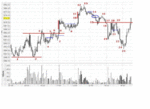Looks like no more takers, so . . .
Quote:
Originally Posted by Szimba
If this game is free for everyone,than here is my view:
1: Price denied to close back under the previous SL created by bars number 4-5-6. Indicates that traders were interested int hat price to buy.
2: This the retest of the potential support from point number 1. Since at this point buying pressure lift price that is what makes point 1 and 2 significants.
3,5,6: All of them are retests of the SH made between point 1 and 2. Every time price declined from this area, that is what gives significance to point 8, where price finally managed to elevated higher by buyers.
So far, so good. Nice job. Your focus is on what's in front of you rather than on what's going to happen next or on what you think you should be doing about it.
Quote:
4,7 : Nothing special. Just pullbacks int h middle of a range.
Oops. What's special about 4 is that (a) it's a higher low and (b) if it holds, you've defined your trend. What's special about 7 is that it's an even higher low, and push is coming to shove. The release of all that pent-up energy at 8 is a confirmation of all that has come before. Note also the ease with which price rises during that portion of 8 before which there are no immediately-preceding trades. This creates an air pocket.
Quote:
9: This is the test of S from 3-5-6 and as buyers stepped back in one can reasonable expect at least the retest of the SH between 8 and 9. The action is significant as it happens on support!
Note also that it "fills" the pocket. Price is not required to move all the way back to the line drawn by the trader.
Quote:
10,11,12,13 The continuation of the trend through previous SHs.
Worth noting, though, that price at 10/11 makes a higher high, confirming the ongoing trend. The red portion again represents another pocket.
As for 12/13, here, finally, volume becomes significant (the volume that is grayed out is grayed out for a reason) and worth paying attention to. Price closes off the highs, buying pressure is insufficient at 13 to push price higher and trading activity is less (i.e., sellers have little trouble preventing price from making a new high; if they had had more trouble doing so, trading activity would have been higher). All of this suggests the last of the distribution.
Quote:
14: This is a significant point as this is represent the break of the uptrend, break uf potential support from the SH between 8 and 9 and here we also have a lower high and a lower low now.
The uptrend isn't broken quite yet. 14 is there to point to that 5-7 bar consolidation just below the high. In a longer bar interval, this would be a doji. This is a fish-or-cut-bait point. The uptrend is broken between here and 15.
Quote:
15: price finds support as selling exhausted for the moment and buyers pushed the price up to previous support now resistance at 16.
17 ,18 sellers won and price decline didn’t manage to stop not even at potential support that originated from 3-5-6-9.
And the plunge itself confirms the importance of all that had been thought to be support, in addition to defining the trend reversal.
Quote:
20,22 significant points as price here tested previous support from 15 and finally turned south as selling interest was heavy from market participants. Price declined until found enough buying interest at 24 and 25.
And here again volume becomes important for only the second time in the chart. Trading activity is far less at 25. That plus what can now be seen as an SC at 24 suggests that sellers are done. This is confirmed by the character of the bar that prints three bars after 25.
Quote:
Regards
Szimba
Thanks for playing.
Db
firewalker99 said:
I think a lot of the points are significant if you place them in the context of what happened next. I'm not sure how you're going to exploit the things you see while they're developing at the moment itself. After you've been able to indicate it was indeed a significant point, it will already have passed. Also, how would one profit from identifying significant points in hindsight?
😕
Assuming 3 had been regarded as an upward break, then left of 4 would have been the first swing low with a long entry around the blue line depending on your rules, then another left of 7 and another left of 9 (you might have been shaken out by 9 if making a more aggressive entry here).
The next potential swing low left of 14 failed but did signal the trend change (blue elipse) and the aggressive would have stopped and reversed here. On a purely mechanical basis 16 didn't make it as a swing high - although it clearly is in hindsight - and the next one was 20 although you might have been shaken out by 22 which - clear in highsight again - was the true swing high at this point.
Assuming you were still short, or had re-entered short after 22, there was nothing mechanical to cause you to cover at the 25 point and that would have had to rely on having the skill to conduct the sort of analysis you have given.
mmm.
good trading
jon


